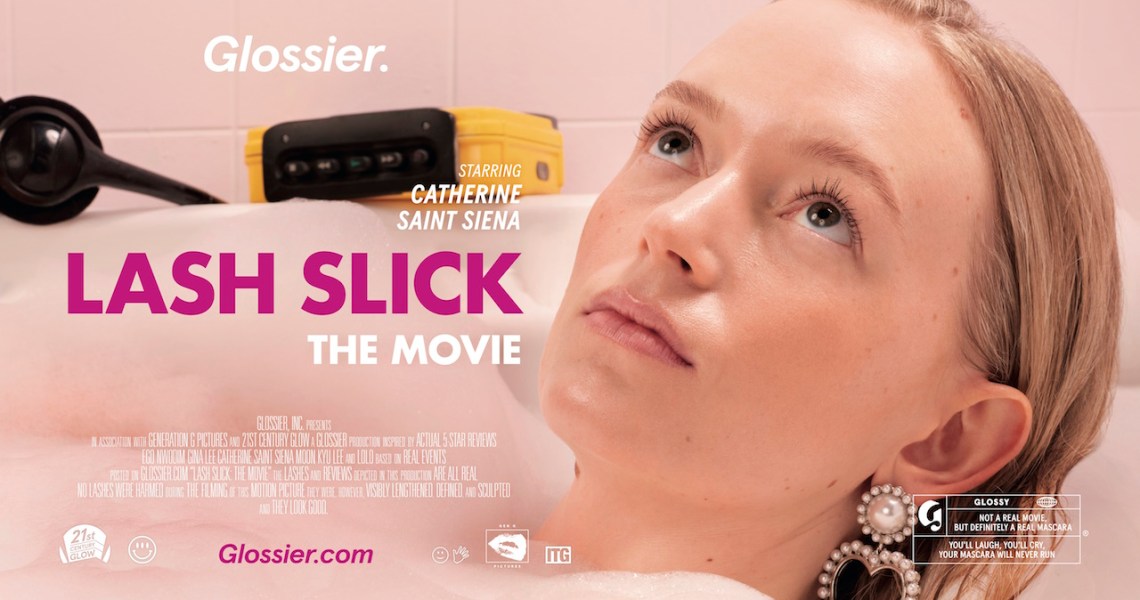Glossier is evolving its storytelling ad format with a movie-themed campaign for its Lash Slick mascara.
In a new campaign that launched on March 15, Glossier unveiled a series of five movie trailers centered on the mascara. The ads bring to life cultural nostalgia, product playfulness and performance, and customer testimonials. The trailers are playing across Glossier’s social channels, and linear and OTT TV, and pay homage to different movie genres such as indie, romantic comedy, film noir and anime and as a compilation. In addition to the trailers, Glossier took over nine movie theater marquees and poster displays in Los Angeles, Chicago and Boston and more. Ali Weiss, Glossier’s svp of marketing, said the campaign was inspired by customer reviews as a way to “bring the drama behind the reviews to life.” Glossier Lash Slick was in its top-five best-selling products in 2020, based on revenue. Over 1 million units have been sold, said Weiss.
“Ultimately the value proposition of Lash Slick is that it’s a black mascara, so we are able to really focus on the storytelling because [we don’t need to explain mascara],” said Weiss. “Within our broader community, we already have advocacy built in, and this enabled us to have fun and not be too serious.”
It’s been about a year since cities like New York City have had open movie theaters. Some NYC theaters started to reopen in March. while theaters in many other cities reopened in Oct. 2020. Dozens of movie release dates have been pushed back until there is a better guarantee of an audience. Glossier’s Lash Slick campaign, therefore, arrives when people are nostalgic for movies. It also intersects with referential nostalgia to ’90s and mid-aughts movies. On TikTok, where it has nearly 95,000 followers, Glossier further expanded this approach with videos inspired by “Sex and the City” and Wes Anderson films. (Anderson’s latest film, “The French Dispatch,” has been postponed.) The primary goal of the campaign is brand awareness, followed by sales impact and new customer acquisition, said Weiss.
In the case of traditional mascara ads, hyperbolic copy like “explosive,” “impact” and “dramatic” are frequently used. This style of theatrical artifice has come under fire for misrepresenting the mascara’s efficacy. In contrast, Glossier’s cinematic approach is more committed to reality by relying on customer testimonials to convey the effects of the product.
“There’s a moment in time, and there’s a feeling of what we want to give our community or what we feel like people want to see,” said Marie Suter, Glossier vp creative director. “We were excited about this idea, with the movie theaters [offering] a different type of image after a year of at-home or UGC [produced content].”
Glossier’s media mix for the campaign is 80% digital and linear ads on channels like Bravo and E!, and 20% out-of-home ads. According to the Out of Home Advertising Association of America’s latest data, OOH ad revenue was down 36% year-over-year in the third quarter of 2020. However, a Harris Poll of 1,000 people in January indicated people are more receptive to OOH ads, due to digital burnout and a desire to seek out-of-home activities. Glossier has frequently relied on OOH ads, most recently for its Oct. 2020 body care launches. Weiss said she anticipates that people will increasingly spend more time outdoors and engage with their surroundings.
“We don’t ever follow a singular formula for our campaigns. They can start with a media idea or a consumer review, or something that someone was inspired by on a trip,” said Weiss.
Ad position: web_incontent_pos1




